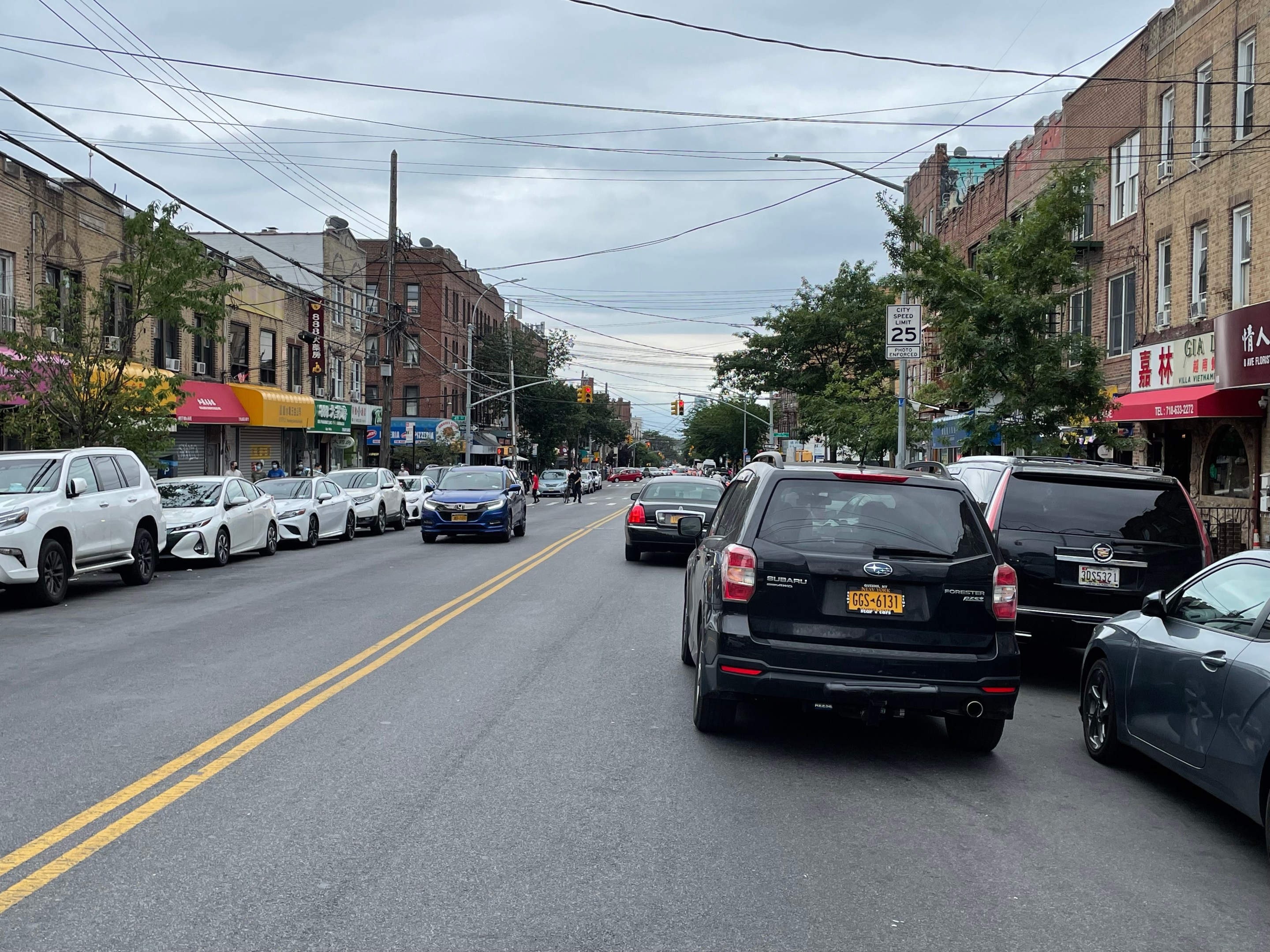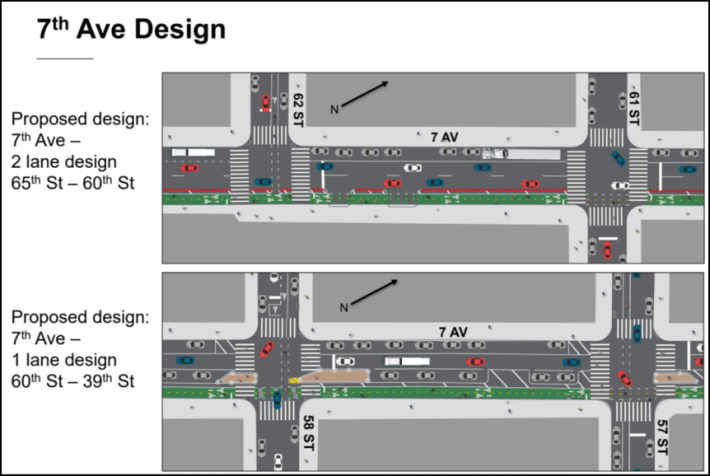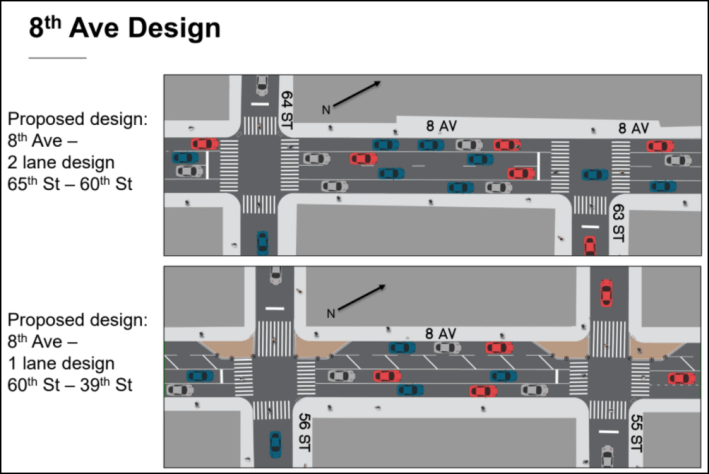ANATOMY OF A BACKTRACK: DOT’s New Sunset Park Plan Gives Safety to Some, Double-Parking Madness For Others
12:01 AM EDT on November 1, 2021

A double parked minivan in front of a double parked car on Eighth Avenue in Sunset Park. Photo: Dave Colon
The city's plan to redesign a pair of traffic-choked, dangerous roadways in the heart of Sunset Park has been turned into a plan to add safety improvements on one avenue but move cars at all costs on another, a symbol of the de Blasio administration's haphazard approach to Vision Zero.
On Wednesday, the Department of Transportation announced that it had altered its original ambitious plan [PDF] to bring safety-first redesigns to Seventh and Eighth avenues between 39th and 65th streets in Brooklyn's Sunset Park. The original plan would have transformed a pair of two-way stretches — Seventh Avenue, a mixed residential and commercial zone, and Eighth Avenue, the commercial heart of Chinatown — into one-way streets with protected bike lanes. The city's new plan — released after opposition from some neighborhood interests groups — retains the one-way routing, but only features a bike lane, albeit two-way, on Seventh Avenue. The plan would provide safe travel and traffic calming on that roadway and a bike-at-your-own-risk scenario on Eighth Avenue, a pullback that left street safety activists scratching their heads in confusion.
"I'm kind of speechless. I don't know what to make of Eighth Avenue, I don't even know what you'd call that," said Bike New York Director of Advocacy Jon Orcutt, who also served as the Director of Policy at the DOT from 2007 to 2014.
The current mess
In their current two-way configuration, Seventh and Eighth avenues in Sunset Park fail virtually all users: cyclists are endangered. Pedestrians are crammed into narrow sidewalks in busy commercial strips. Bus riders on Eighth Avenue are stuck — in both directions — whenever there is a double-parked car or truck.
The roadways are also dangerous: Eighth Avenue between 39th and 66th streets was tied for the most pedestrians killed or severely injured on any of the north-south street in Community Boards 7, 10 and 12. Between January 2019 and September 2021, there were 808 total crashes on the stretches of Seventh and Eighth avenues that the DOT wanted to give its ambitious redesigns to, resulting in two pedestrian deaths, 41 cyclist injuries, 84 pedestrian injuries and 63 motorist injuries according to CrashMapper.
The neighborhood is Vision Zero priority area, according to DOT.
In addition to knowing how dangerous Seventh and Eighth avenues were, the DOT also had survey data that showed 88 percent of people got to the thoroughfares on foot or on public transportation. Surveys of merchants on the avenues showed that 58 percent of small business owners said that they had problems receiving deliveries to their shops specifically because of a lack of dedicated loading space.
So in November 2020, the DOT told Brooklyn Community Board 10 that it was looking at transforming the two-way streets into one-way streets in the interests of finally solving the pedestrian safety issues wrought by drivers constantly trying to get around double-parked cars. The November presentation didn't include any ideas beyond making the stretches one-way, but emphasized reworking the road would leave room "for re-allocation of roadway space to provide safety and mobility benefits for additional users."
By May, the DOT revealed that it was planning on adding protected bike lanes on each street once they were transformed into one-way streets. But this time, the DOT learned from an earlier — and positively toxic — confrontation the agency had with Park Slope residents more than a decade ago when it sought to change parts of Sixth and Seventh avenues into one-way stretches — but do so without any pedestrian or bike improvements that might have mitigated the anticipated speedway conditions. So this time, the DOT included bike lanes and expanded pedestrian space. Nonetheless, the Sunset Park proposal came under fire in part for the bike lane proposal, which would have been responsible for removing most of the 183 lost parking spots.
Opposition grows
Despite the safety data and the survey data that the city had at its disposal, the DOT was still swamped by complaints from local merchants that the changes to Eighth Avenue would devastate their businesses, itself a common objection to bus lanes or bike lanes before they get installed.
But where other controversial projects may have had strong organizing from elected officials and street safety advocates to encourage the DOT, the political weight in this case was thrown behind local merchants.
Sunset Park's sitting Council Member Carlos Menchaca gave one interview in which he supported the project, but later criticized the DOT's outreach efforts and did not otherwise publicly back the project or respond to any subsequent requests from Streetsblog to talk about the street redesign.
The neighborhood's incoming Council member, Alexa Avilés, also gave cover to opponents of the plan in an October tweet thread in which she explained that her opposition mostly centered on the process that she said didn't sufficiently respect the neighborhood's Chinese residents. In an interview with Streetsblog, Avilés blamed the DOT for not explaining how the various pieces of the project fit together to make the Seventh and Eighth avenues safer.
Assembly Member Peter Abbate, who in March said that his primary concern for the plan was making sure that cars had room to move, later was part of a lawsuit by local merchants that was ultimately settled over the summer. When the DOT returned to Community Boards 7, 10 and 12 in the fall, the agency did not suggest any major changes to the plan that opponents said was so controversial.
But then Mayor de Blasio told reporters he wanted DOT Commissioner Hank Gutman to alter the project because people were upset.
"I have spoken to Commissioner Gutman on this issue, and he is going to go and have deeper engagement with the community because I do not think it’s mutually exclusive to have safe streets and also address community concerns," de Blasio said on Monday, two days before the DOT issued the new renderings. "So, for example, you could want to ensure safety. There’s more than one way to do that. Sometimes that’s a bike lane. Sometimes that’s other safety measures. Sometimes it’s a combination. And you do need to look at the other factors in the community. You do need to look at, for example — I’ve always felt this — you got to look at what’s happening with jobs and small business and keeping neighborhood businesses alive."
Meet the new plan
The city's new proposal seems to be designed by people who thought King Solomon would have been smart to actually cut a baby in half.
On Seventh Avenue, the DOT now seeks to install a two-way, parking-protected bike lane on the east side between 39th and 60th streets, routing the previously two-way traffic into one southbound lane. The agency is also painting pedestrian refuges at intersections which will initially be protected by plastic sticks. The protected bike lane will continue to 65th Street, but lose the bulk of its protection: south of 60th Street, drivers will get a second travel lane (a DOT spokesperson did not say what type of barrier would keep cars out of that bike lane, though renderings suggest stiffer plastic posts than elsewhere.)

Eighth Avenue would still become a one-way northbound route, but no longer get a protected bike lane. The DOT is keeping an expanded sidewalk between 51st and 60th streets that it proposed in its original redesign, and said that loading zones will be added to the blocks in some way. But the protected bike lane was sacrificed for a wide painted median next to the west side parking lane, a move that left DOT veterans mystified as to what the point of the redesign was.
"Seventh Avenue looks like it will be better than the original proposal," said Bike South Brooklyn co-founder Brian Hedden. "The result will be a continuous, two-way path on the same avenue, from 79th Street to 39th Street. It will be a great way to connect Bay Ridge residents with Sunset Park's Seventh Avenue businesses. It's just too bad that Eighth Avenue businesses will be left out of that, too bad that there are almost no Bay Ridge business accessed through protected bike lanes that Sunset Park residents can connect to, and very concerning that road users on Eighth Avenue will continue to be at risk."

The problems with the new plan
By putting a bike lane on one dangerous stretch but not the other, the DOT's best suggestion has been that anyone who needs to ride a bike on Eighth Avenue just use the Seventh Avenue bike lane and be happy about it. The new plan also creates an unofficial double-parking zone where trucks might be able to unload if people aren't parking their cars in the painted buffer, critics of the new plan noted that the agency blew an opportunity to update the city's bike lane design in a way that worked with the commercial reality of constant all-day delivery.
"We have this problem all over the city, curb access. If that's the issue here, why not come up with a bike lane and loading zone design where the trucks aren't in bike lane? We need that everywhere," said Orcutt. "Trucks in the moving lane pushing traffic into the put bike lanes is a ubiquitous issue in New York City today. On Queens Boulevard, if there's one double parked car, you have trucks and buses driving in the bike lane. The same with Grand Concourse. And here's a place where people are saying we need curb access and we need safety and we need bike lanes. And when you one-way these streets, there's a lot of space to do that. Why couldn't you just put loading zones in and figure it out? The real estate is there on both of those avenues."
Painted bump-outs next to crosswalks will theoretically shorten crossing distances for pedestrians, provided that drivers don't park in the plastic-stick-protected areas or the edges of the median that anyone with eyes can see will most likely become a double-parking zone.
"If one is genuinely concerned with curb access and visibility, there are better solutions that creating a buffer zone that every driver is going to treat as a double-parking lane," Bike South Brooklyn tweeted about the baffling decision to trade the bike lane for a median.
Also, if one is genuinely concerned with curb access and visibility, there are better solutions than creating a buffer zone that every driver is going to treat as a double parking lane. pic.twitter.com/YqPoZIJ9ah
— Bike South Brooklyn! (@BikeSouthBklyn) October 27, 2021
"We didn't mean you should actually do this!" Bike New York tweeted more cynically above a tweet suggesting even official double-parking lanes would calm streets in some fashion.
Wait @NYC_DOT we didn’t mean you should actually do this! https://t.co/rMH3NKvT01
— Bike New York (@bikenewyork) October 28, 2021
The DOT said that the purpose of the median was for traffic calming. "By visually narrowing the roadway, the buffer will encourage slower speeds on the corridor," according to a spokesperson for the agency.
What are people saying now?
With only half of the actual safety issue solved, there are still enough unknowns and problems with the plan that the only people it leaves happy are the people who sued to stop it. Some people were confused as to why the plan was rushed out in the form it was, since a new mayor and potentially new DOT commissioner will be running the agency in a matter of months.
"You're not going to get off your bike on Seventh Avenue and walk along one block on the next avenue. The whole thing is bad. If you couldn't get this thing through the community or elected or incoming elected, there was no need to do this project and announce it this way. You could have just played out the string and left it for the next team next year," said Orcutt.
Avilés did not commit to pushing for a bike lane on Eighth Avenue, but issued a statement saying that the painted median was a waste of space that didn't help anyone.
"We don’t have a complete picture of the new plan yet, but you can expect I’ll be proactive with DOT to iterate on changes to keep improving our streets, because that kind of proactive listening and organizing has been missing in our district," Avilés said. "We can do better than this version of this plan."
For all the questions about ignoring the community, the city also didn't talk to deliveristas about the project, even though delivery workers need to safe passage to and from restaurants Seventh and Eighth avenues. Advocates for delivery workers said that they welcomed the Seventh Avenue lane at least, even if they would have to wait and see what happened on Eighth Avenue.
"Any space where there's a a bike lanes available, we see that as a positive move," said Workers Justice Project spokesperson Hildalyn Colon Hernandez. "This gives [riders] a pathway, because right now there's no path. It's not the perfect alternative, but it gives them an alternative."
Abbate, who was widely quoted in the agency's handout announcing the new project, was able to bend Gutman's ear in favor of listening to the area's business community, which led to a bizarre spin out of the agency in which Gutman explained safety was the agency's first priority...unless it wasn't.
"These are Vision Zero priority corridors, and our top priority was to make sure they were safe," the agency tweeted (enjoy reading the quote tweets) in a retweet of a largely anodyne Brooklyn Eagle story. "But we are also aware that Eighth Avenue is unique in its density of commercial activity and its role as the heart of Brooklyn’s Chinatown."
"These are Vision Zero priority corridors, and our top priority was to make sure they were safe. But we are also aware that Eighth Avenue is unique in its density of commercial activity and its role as the heart of Brooklyn’s Chinatown..." - Cmsr Gutmanhttps://t.co/eh8d0FzBID
— NYC DOT (@NYC_DOT) October 27, 2021
The new plan was also released at a time when the DOT was already under fire for putting business interests before safety interests.
The "safety second" backtrack on Eighth Avenue is a outer-borough version of what the mayor did to his proposed busway and bike lane project on Fifth Avenue in Manhattan after real estate developer Steven Roth co-opted safe street language to successfully convince the mayor that speeding buses would put pedestrians more at risk than speeding cars. Activists were confounded at the idea that the DOT could still possibly believe the claim that a bus or bike lane would destroy a commercial business, given the lack of evidence along corridors like 14th Street, Queens Boulevard and 43rd Avenue.
"I'm deeply disappointed to hear Commissioner Gutman repeat dumb and tired tropes about bike infrastructure interfering with businesses. Commercial doomsday has been predicted everywhere protected bike lanes have been proposed and it's never happened," Hedden said.
The future of the project's implementation is somewhat up in the air as well. With the announcement of the new plan coming so close to the end of the DOT's street work season, the agency said that it would focus on finishing pedestrian safety improvements on the six most dangerous intersections on Eighth Avenue, but those have not been identified by the agency yet.
A DOT spokesperson also said that the city is still working out exactly how many parking spots the plan will take away, where planned loading zones will go and other details that impact the curb space. It is also yet to be seen if the one-way redesign on each block will impact the B70 bus, which will now run separate north and south routes on each avenue, if a single car or truck blocks the traveling lane.
Dave Colon is a reporter from Long Beach, a barrier island off of the coast of Long Island that you can bike to from the city. It’s a real nice ride. He’s previously been the editor of Brokelyn, a reporter at Gothamist, a freelance reporter and delivered freshly baked bread by bike. Dave is on Twitter as @davecolon. Email Dave Colon at dcolon@streetsblog.org
Stay in touch
Sign up for our free newsletter
More from Streetsblog New York City
New York City to Install 500 Secure Bike Parking Hubs In The Next Five Years: Sources
Your bike may finally get a roof over its head.
Adams Backs Lower Speed Limits, Calls Crashes ‘Accidents’
The mayor wants New York City drivers to "slow down," but it's not clear yet how many streets will get lower speed limits.
Wednesday’s Headlines: Trump Posts About Congestion Pricing Edition
Donald Trump comments on congestion pricing — no surprise, he's against it. Plus more news.
DOT Aims to Build First Ave. Tunnel Bike Lane Before September’s UN General Assembly
DOT hopes to have the concrete-protect tunnel bike lane installed this summer, but its exact plans are still in development.
Waste Reforms Could Require Data on Crashes, Dangerous Driving
The proposal affects at least one trucking company with a deadly driving record.




